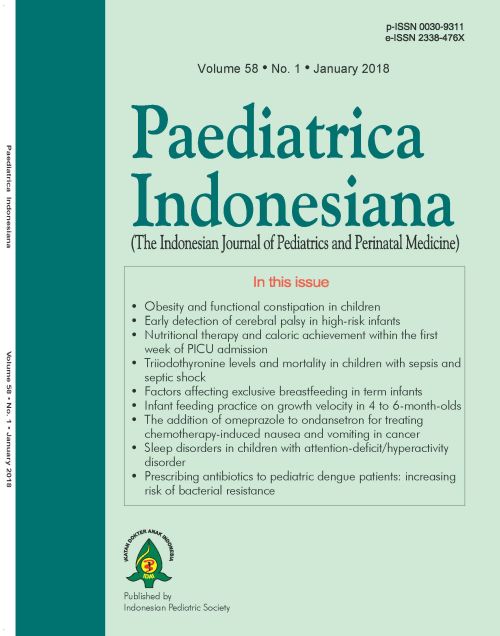Nutritional therapy and caloric achievement within the first week of PICU admission
Abstract
Background Nutritional therapy is an important aspect in managing PICU patients. Careful decisions should be made regarding initiation, route of administration, and achievement based on caloric requirements. Many conditions could affect the application of nutritional therapy.
Objective To investigate the implementation of nutritional therapy during the 1st week after PICU admission.
Methods We conducted a retrospective study involving 156 children aged 1 month-18 years who were hospitalized for at least 4 days in the PICU during the period of January 1st, 2015 to December 31st, 2015. Subjects were divided into three groups according to initiation time of caloric administration, which were: category I (within the first 24 hours of PICU admission), category II (within the first 25-48 hours of PICU admission), and category III: (more than 48 hours after PICU admission). Caloric requirement was calculated using the Caldwell or Schofield formula, whilst caloric achievement was figured up from PICU daily monitoring sheets containing nutritional therapy given to the subjects.
Results Of 131 subjects, 72 (55%) had good nutritional status and 59 (45%) children had malnutrition. Caloric administration was initiated within 24 hours of admission in 101 (77.1%) patients, of whom 90 (89.1%) patients received enteral feeding. Nineteen (14.5%) patients received their initial calories within 25-48 hours of admission, with 16 (84.2%) using the enteral route. At the 4th and 7th days of hospitalization, 93 (71%) and 107 (81.7%) patients achieved >70% of their caloric requirements. Delays in feeding initiation were due to shock, gastrointestinal bleeding, inotropic support, and feeding intolerance, which reduced caloric achievement.
Conclusion Most patients receive nutritional therapy in the first 48 hours after PICU admission and achieve >70% of their caloric requirements at the 4th day of hospitalization. The enteral route is preferred. Delayed initiation of nutritional therapy reduce caloric achievement.
References
2 Mikhailov TA, Kuhn EM, Manzi J, Christensen M, Collins M, Brown AM, et al. Early enteral nutrition is associated with lower mortality in critically ill children. J Parenter Enteral Nutr. 2014;38:459-66.
3 Artinian V, Krayem H, DiGiovine B. Effects of early enteral feeding on the outcome of critically ill mechanically ventilated medical patients. Chest. 2006;129:960–7.
4 Mehta N, Bechard L, Cahill N, Wang M, Day A, Duggan C, et al. Nutritional practices and their relationship to clinical outcomes in critically ill children-an international multicenter cohort study. Crit Care Med. 2012;40:2204–11.
5 Patel JJ, Kozeniecki M, Biesboer A, Peppard W, Ray AS, Thomas S, et al. Early trophic enteral nutrition is associated with improved outcomes in mechanically ventilated patients with septic shock?: a retrospective review. J Intensive Care Med. 2016;31:471–7.
6 Beausejour M, Bockenkamp B, Jouvet P, Arsenault V, Pelletier V-A. Assessment of calories prescribed and delivered to critically ill children. e-SPEN, theEuropean e-Journal of Clinical Nutrition and Metabolism. 2009;4:172–5.
7 de Neef M, Geukers VG, Dral A, Lindeboom R, Sauerwein HP, Bos AP. Nutritional goals, prescription and delivery in a pediatric intensive care unit. Clin Nutr. 2008;27:65–71.
8 Hardy CM, Dwyer J, Snelling LK, Dallal GE, Adelson JW. Pitfalls in predicting resting energy requirements in critically Ill children: a comparison of predictive methods to indirect calorimetry. Nutr Clin Pract. 2002;17:182–9.
9 Meyer R, Kulinskaya E, Briassoulis G, Taylor RM, Cooper M, Pathan N, et al. The challenge of developing a new predictive formula to estimate energy requirements in ventilated critically Ill children. Nutr Clin Pract. 2012;27:669–6.
10 Burritt E. Use of indirect calorimetry in the pediatric intensive care unit. Infant, Child, Adolesc Nutr. 2010;2:246–50.
11 Silva FM, Bermudes AC, Maneschy IR, Zanatta Gde A, Feferbaum R, Carvalho WB, et al. Impact of early enteral nutrition therapy on morbimortality reduction in a pediatric intensive care unit?: a systematic review. Rev Assoc Med Bras. 2013;59:563–70.
12 Zamberlan P, Delgado AF, Leone C, Feferbaum R, Okay TS. Nutrition therapy in a pediatric intensive care unit: Indications, monitoring, and complications. J Parenter Enteral Nutr. 2011;35:523–9.
13 Franca T, Ishikawa L, Zorzella-Pezavento S, Chiuso-Minicucci F, Cunha M da, Sartori A. Impact of malnutrition on immunity and infection. J Venom Anim Toxins incl Trop Dis. 2009;15:374–90.
14 McClave SA, Chang W. When to feed the patient with gastrointestinal bleeding. Nutr Clin Pract. 2005;20:544–50.
15 Guillaume A, Seres DS. Safety of enteral feeding in patients with open abdomen, upper gastrointestinal bleed , and perforation peritonitis. Nutr Clin Pract. 2012;27:513–20.
16 Hurt RT, Frazier TH, McClave SA, Crittenden NE, Kulisek C, Saad M, et al. Stress prophylaxis in intensive care unit patients and the role of enteral nutrition. J Parenter Enteral Nutr. 2012;36:721–31.
17 Mehta NM. Approach to enteral feeding in the PICU. Nutr Clin Pract. 2009;24:377–87.
18 McClave SA, Taylor BE, Martindale RG, Warren MM, Johnson DR, Braunschweig C, et al. Guidelines for the provision and assessment of nutrition support therapy in the adult critically ill patient: Society of Critical Care Medicine (SCCM) and American Society for Parenteral and Enteral Nutrition ( A .S.P.E.N.). J Parenter Enteral Nutr. 2016;40:159–211.
19 Mehta NM, Compher C, ASPEN Board of Directors. A.S.P.E.N. Clinical Guidelines: nutrition support of the critically ill child. J Parenter Enteral Nutr. 2009;33:260–76.
20 Panchal AK, Manzi J, Connolly S, Christensen M, Wakeham M, Goday PS, et al. Safety of enteral feedings in critically ill children receiving vasoactive agents. J Parenter Enteral Nutr. 2016; 40: 236–41.
21 Lee H, Koh SO, Kim H, Sohn MH, Kim KE, Kim KW. Avoidable causes of delayed enteral nutrition in critically ill children. J Korean Med Sci. 2013;28:1055–9.
22 Martinez EE, Bechard LJ, Mehta NM. Nutrition algorithms and bedside nutrient delivery practices in pediatric intensive care units?: an international multicenter cohort study. Nutr Clin Pract. 2014;29:360–7.
Authors who publish with this journal agree to the following terms:
Authors retain copyright and grant the journal right of first publication with the work simultaneously licensed under a Creative Commons Attribution License that allows others to share the work with an acknowledgement of the work's authorship and initial publication in this journal.
Authors are able to enter into separate, additional contractual arrangements for the non-exclusive distribution of the journal's published version of the work (e.g., post it to an institutional repository or publish it in a book), with an acknowledgement of its initial publication in this journal.

This work is licensed under a Creative Commons Attribution-NonCommercial-ShareAlike 4.0 International License.
Accepted 2018-02-15
Published 2018-03-20












